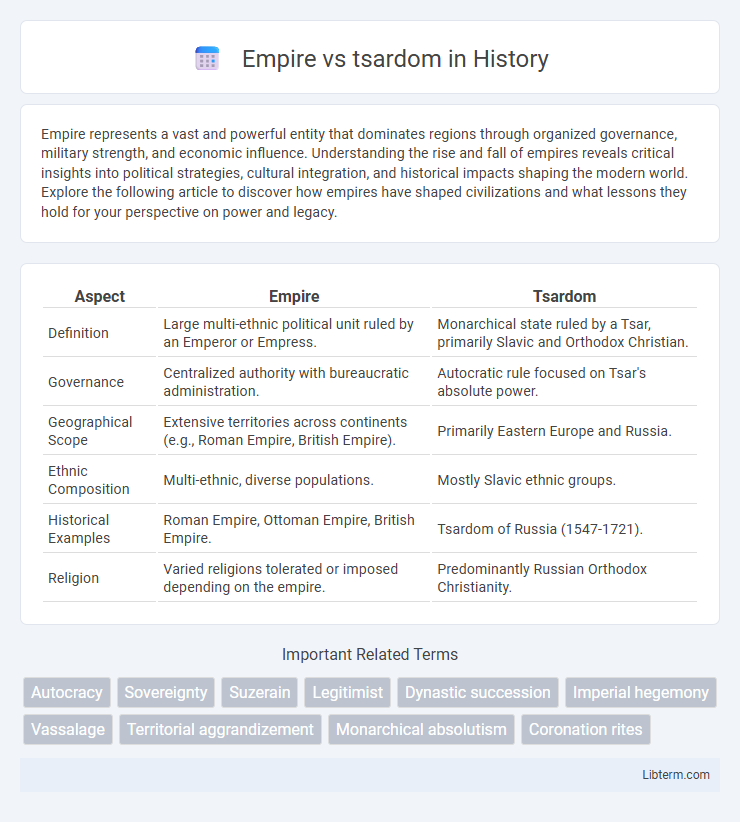Empire represents a vast and powerful entity that dominates regions through organized governance, military strength, and economic influence. Understanding the rise and fall of empires reveals critical insights into political strategies, cultural integration, and historical impacts shaping the modern world. Explore the following article to discover how empires have shaped civilizations and what lessons they hold for your perspective on power and legacy.
Table of Comparison
| Aspect | Empire | Tsardom |
|---|---|---|
| Definition | Large multi-ethnic political unit ruled by an Emperor or Empress. | Monarchical state ruled by a Tsar, primarily Slavic and Orthodox Christian. |
| Governance | Centralized authority with bureaucratic administration. | Autocratic rule focused on Tsar's absolute power. |
| Geographical Scope | Extensive territories across continents (e.g., Roman Empire, British Empire). | Primarily Eastern Europe and Russia. |
| Ethnic Composition | Multi-ethnic, diverse populations. | Mostly Slavic ethnic groups. |
| Historical Examples | Roman Empire, Ottoman Empire, British Empire. | Tsardom of Russia (1547-1721). |
| Religion | Varied religions tolerated or imposed depending on the empire. | Predominantly Russian Orthodox Christianity. |
Defining Empires and Tsardoms
Empires are extensive political entities characterized by diverse populations, centralized authority, and control over vast territories often acquired through conquest and colonization. Tsardoms specifically refer to monarchies ruled by a tsar, predominantly in Eastern Europe and Russia, where the tsar held supreme autocratic power over a centralized state. While empires encompass broader multiethnic domains with complex governance systems, tsardoms emphasize dynastic rule and the fusion of political and religious authority.
Historical Origins and Evolution
The historical origins of empires trace back to early civilizations like Mesopotamia and Ancient Egypt, where centralized authority expanded over diverse territories through conquest and assimilation. Tsardoms emerged primarily in Eastern Europe and Russia during the medieval period, evolving from fragmented principalities into autocratic states led by tsars, who combined religious and political power. Over time, empires developed complex bureaucracies and multicultural governance, whereas tsardoms emphasized centralized control and Orthodox Christian legitimacy, influencing their distinct evolutionary trajectories.
Governance Structures Compared
Empire governance structures typically centralized power under an emperor with a broad bureaucratic system managing diverse territories and ethnic groups, emphasizing imperial law and administrative hierarchies. In contrast, tsardom governance, as seen in Russia, concentrated authority around the tsar, who combined autocratic rule with Orthodox Church influence, often integrating military nobility into governance through the boyar council. While empires relied on complex bureaucracies to govern vast multicultural domains, tsardoms maintained tighter personal control and social hierarchy rooted in feudal traditions and religious legitimacy.
Leadership and Succession
Empire leadership often centralized power in a single ruler, such as an emperor, with complex bureaucratic systems to support governance and ensure continuity through established succession protocols. Tsardom leadership emphasized autocratic rule under the tsar, where succession frequently followed hereditary lines but was vulnerable to disputes and power struggles due to less formalized succession laws. Both systems shaped political stability and state development by balancing authority concentration with mechanisms to manage leadership transitions.
Territorial Expansion Strategies
Empires employed centralized governance and military conquest to annex diverse regions, leveraging advanced logistics and diplomatic alliances to secure vast territories across continents. Tsardoms, particularly the Russian Tsardom, focused on gradual eastward expansion through colonization, military fortifications, and assimilation of indigenous populations in Siberia and surrounding areas. Both entities prioritized control of strategic trade routes and natural resources to sustain and legitimize their territorial growth.
Administrative Systems and Bureaucracy
The empire often featured a centralized administrative system with a complex bureaucracy designed to manage vast, diverse territories through appointed officials and standardized laws. In contrast, the tsardom relied heavily on autocratic rule, where administrative power was concentrated in the Tsar and his close advisors, with less formalized bureaucratic institutions. The empire's bureaucracy emphasized institutional governance and regional governors, while the tsardom mixed personal loyalty networks and evolving administrative structures to maintain control.
Military Organization and Influence
The military organization of the Empire was characterized by a centralized command structure with professional standing armies, extensive use of advanced weaponry, and systematic training regimes, enabling rapid mobilization and sustained campaigns. In contrast, the Tsardom relied heavily on feudal levies and Cossack irregulars, with decentralized command and limited standardization, resulting in variable combat effectiveness and slower mobilization. The Empire's military influence extended across multiple continents through disciplined, technologically superior forces, while the Tsardom's influence was more regionally confined, relying on strategic alliances and adaptive guerrilla tactics to counter larger foes.
Cultural and Religious Dimensions
The cultural landscape of the Russian Empire was deeply shaped by its Orthodox Christian tsardom roots, where the Orthodox Church played a central role in legitimizing imperial authority and fostering a unified identity among diverse ethnic groups. The tsardom emphasized the symbiotic relationship between the crown and the church, reinforcing autocracy through religious rituals and institutions such as the Moscow Patriarchate. In contrast, the expanding empire incorporated numerous non-Orthodox populations, which led to policies of religious tolerance intertwined with efforts at Russification, illustrating the complex dynamic between preserving Orthodox cultural dominance and managing the empire's vast multicultural religious fabric.
Decline and Transformation
The decline of the tsardom was marked by internal strife, military defeats, and economic instability, leading to the erosion of autocratic power in Russia. The transformation into an empire involved centralizing authority while expanding territorial control, fostering modernization efforts, and integrating diverse populations under a more complex bureaucratic system. This shift redefined governance structures, paving the way for imperial dominance but also sowing the seeds of revolutionary change.
Legacy and Modern Interpretations
The legacy of the Russian Empire is marked by expansive territorial control and centralized autocratic rule, setting the foundation for modern Russian statehood. The Tsardom of Russia symbolizes the medieval and early modern phase, emphasizing absolutism and Orthodox Christianity, which influenced national identity and cultural traditions. Contemporary interpretations analyze these periods to understand Russia's political evolution, imperial ambitions, and the enduring impact on Eastern European geopolitics.
Empire Infographic

 libterm.com
libterm.com